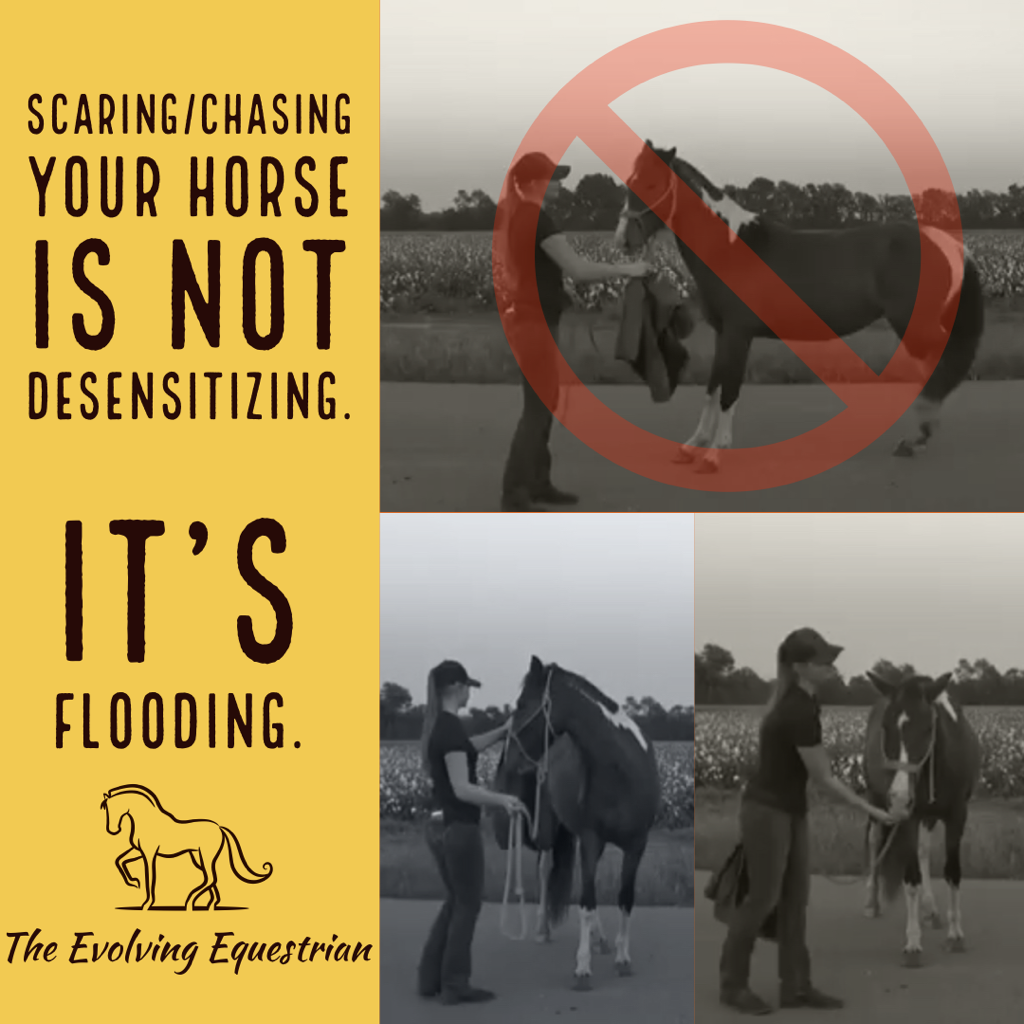|
Scaring your horse is not the same as desensitizing. Chasing your horse around with something he finds scary is also not the same as desensitizing. Trainers who recommend you give your horse a heart attack or act crazy around them to get them desensitized do not understand the correct definition or process of systematic desensitization. Teaching horse owners to continue applying a scary stimulus until the horse shows “a sign of relaxation” after the horse has acted on his fear by moving away or acting fearful, is also an incorrect approach to systematic desensitizing. This actually falls under flooding, not desensitizing. A horse is considered over his fear threshold when the stimulus is at a strong enough intensity and causes a reaction. Shying, bucking, bolting, rearing are very obvious indicators the horse is well over threshold, but the horse is *first* considered over fear threshold when he initially acts on his flight instinct by moving away from whatever he finds frightening. It may be a step backwards or sideways, but if it is a retreat from a scary stimulus, it means the horse is not comfortable and has moved into flight mode. Big reactions aren't the only sign your horse is over threshold. Something as small as a step back can tell you everything you need to know about how your horse is feeling. It's when we ignore these smaller signs that they turn into the big ones. A horse who raises his head, widens his eyes and tenses up is considered at threshold- not over because the stimulus has not yet reached an intensity to cause him to react on his instinct to flee. If you notice any of these signs, back off! Reintroduce the stimulus by starting further away, with less intensity, and for a shorter period of time. Forcing a horse to accept a stimulus at an intensity he is not comfortable with is called flooding. Flooding is a technique where the learner's senses are overwhelmed with a stimulus they may find frightening as a form of desensitizing. The stimulus is inescapable, meaning it does not cease and the learner cannot get away from it even if he is uncomfortable with the level of intensity. Imprinting foals is a common form of flooding. The foal is pinned down on the ground and the handler touches the horse all over, rubs him down with plastic bags, puts their finger in their mouth, etc. The foal may struggle, but the handler continues to expose the foal to whatever he's doing. In studies done on imprinted foals vs foals that were not imprinted, there was no significant difference in their behavior during handling at a later stage. Which is very interesting and very telling. We have all been taught that if the horse moves away in fear we have to keep the stimulus the same because if we give him a "release", he will learn to run away from whatever we are trying to desensitize him to. We have to keep going until the horse stops moving and shows “a sign of relaxation.” This is false. When a horse moves away from a scary stimulus, he is in flight mode/above threshold and is incapable of learning or retaining information. By following or "drifting" with the horse as he moves you are also, unknowingly increasing the intensity- in the horse's mind, now the scary thing is chasing him. This is when things get ugly fast. Jogging after the horse as he runs backwards ensues and it takes quite a while for the horse to come back down below threshold. When the horse finally does stop, it is usually due to learned helplessness and the “sign of relaxation” is actually a displacement behavior. This is all misconstrued as the horse accepting the scary stimulus when in actuality, the opposite has happened. The horse is so frightened he has given up escape. We know that flooding is forcing a horse to accept a stimulus at an intensity that he is uncomfortable with, but we normally consider this as a horse that is physically restrained and unable to move at all. This is not the case. If the stimulus is inescapable, even if the horse is moving, but still cannot get away from the stimulus, it is flooding. Strapping a saddle to a horse and letting him buck it out is flooding, for example. Although he is able to move, he is still unable to get away from or escape the saddle. Flooding is classified as the inability to escape not the inability to run or move. So, when a horse moves away from a flag or plastic bag and we continue to apply the stimulus by restraining him with the lead rope and following him around, we are flooding. Just imagine how well a person might overcome their fear of snakes if someone chased them around with one! Do you think this would help them overcome their fear or rather traumatize them? In systematic desensitization we are introducing a stimulus at an intensity the horse is comfortable with and slowly increasing that intensity and building the horse's confidence as well. If you send the horse above threshold, you should back off and find a better starting point. Decreasing the intensity will not hinder the desensitizing process. It will allow the horse the opportunity to come back down below threshold, where he can process and reason, instead of just panic. Ideally, we try not to push the horse above threshold in the first place. We would pay attention when he shows signs that he is at threshold- when he first takes note of something scary by the classics: raised, head, wide eyes, tense muscles and adjust our intensity, distance, and duration accordingly.
1 Comment
|
AuthorChrissy Johnson shares her personal experiences and lessons learned training horses with reward based methods. Archives
July 2022
Categories |

 RSS Feed
RSS Feed